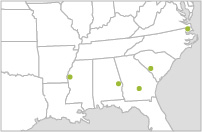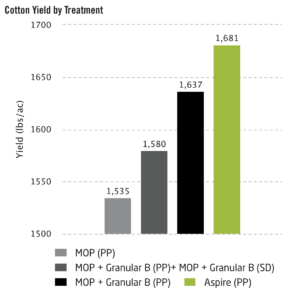OVERVIEW
- Preplant applications of MOP are a common practice in cotton production. Additionally, many growers add B to their preplant and sidedress blends
- Cotton requires B in relatively large amounts compared to other plants. If not present, B is the micronutrient most likely to limit cotton production.
- Boron deficiency in cotton may cause a distorted, stunted terminal, abnormal uppermost leaves and aborted flowers (Fig. A).
- Aspire® is the first-of-its-kind micronutrientenhanced potash fertilizer. Manufactured using Nutriform® technology, Aspire® premium potash combines K and B in each granule to help achieve uniform nutrient distribution.
TRIAL DETAILS
Crop: Cotton (Gossypium hirsutum L.)
Years: 2014
Locations: 5 trials across regions of the U.S. (AL, GA, MS, NC, SC)

Data Source: Field studies conducted by third-party, independent researchers.
Experimental Design: Small-plot RCBD with 4 replications.
Cropping Conditions: All trials conformed to local cropping practices.
Total K Applied: 90 lbs K₂O/ac
Total B Applied:
MOP: 0 lb B/ac
Aspire: 0.75 lbs B/ac
Granular B: 1.5 lbs B/ac
Application Method: Broadcast
Application Timing: Preplant (PP) Sidedress (SD)
RESULTS

SUMMARY
- Cotton yields increased with aEven in situations of split application with 2 times as much B applied (preplant: 60 lbs K₂O/ac + 1.0 lbs B/ac | SD: 30 lbs K₂O/ac + 0.5 lbs B/ac), PP Aspire® (90 lbs K₂O/ac + 0.75 lbs B/ac) increased yield by 101 lbs lint/ac.
- With only half as much boron applied, the preplant Aspire® application (0.75 lbs B/ac) outyielded the preplant application of MOP + Granular B (1.5 lbs B/ac) by 44 lbs lint/ac.
- The higher yields with preplant Aspire® compared to other treatments demonstrates the advantages of the uniform nutrient distribution of boron compared to traditional MOP + Granular B blends and split-application methods.